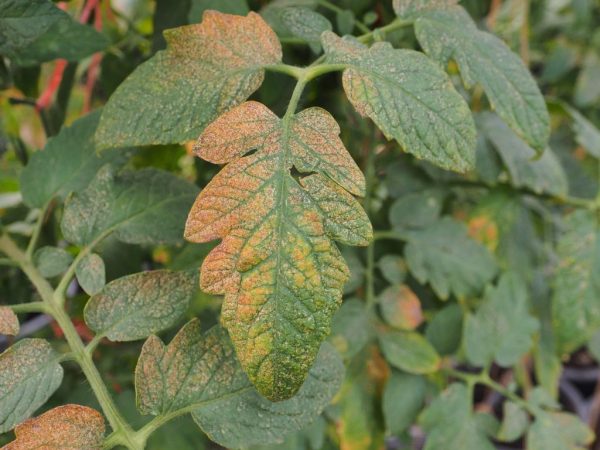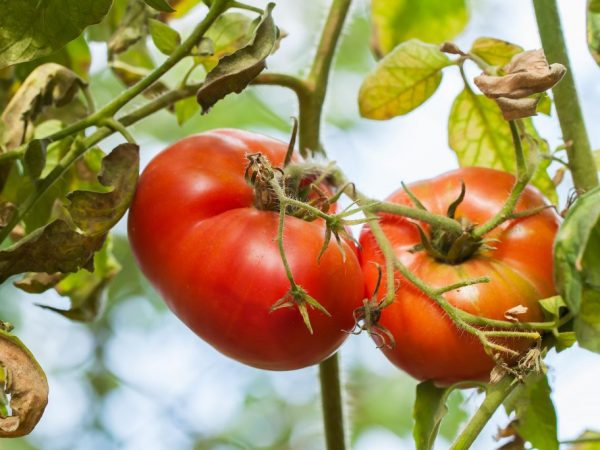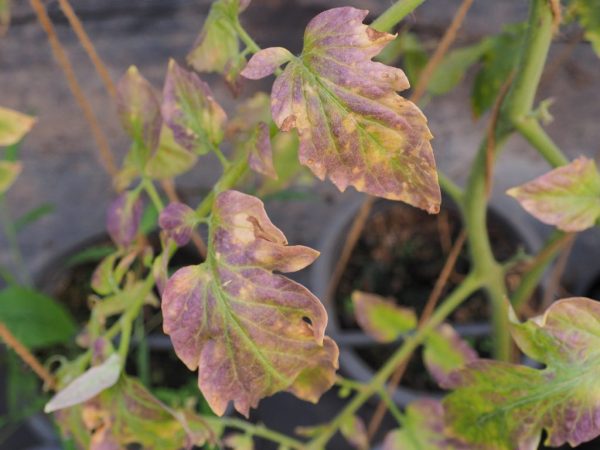Causes of wilting leaves in tomato seedlings
Sometimes the leaves of a tomato wither for natural reasons, but in most cases this is the result of improper plant care. The reasons for wilting and how to solve the problem will be discussed in the article.

Causes of wilting leaves in tomato seedlings
Illiterate feeding
Why do tomato leaves wither? Often the reason is an improperly organized diet. In this case, the problem is caused by both a deficiency and an overabundance of one or another element.
First of all, you need to determine which leaves were affected by the problem.
- If old leaves turn yellow on tomatoes, they lack nitrogen, phosphorus, potassium, magnesium, zinc or molybdenum.
- If the upper shoots of tomatoes wither and turn yellow, then they do not receive enough calcium, chlorine, boron, sulfur, manganese or iron.
Leaf wilting due to a lack of a particular nutrient is easily treated. For this, the application of the necessary fertilizers is regulated.
Nitrogen
The lack of nitrogen in sufficient quantities leads to the fact that the tomatoes do not grow, remain small with sparse foliage. The veins on the leaves turn crimson, then gradually the entire leaf turns yellow and withers. To correct the situation, tomato beds are watered with a urea solution prepared at the rate of 30 g of fertilizer per 10 liters of water.
Phosphorus
Lack of phosphorus is manifested by the purple color of the plant's foliage, tough and brittle stems. Ignoring such signals leads to the death of the roots. To prevent this from happening, 1 tsp is poured under each plant. superphosphate for proper growth.
Potassium
If young leaves twisted into tubes appeared on the tops of tomato beds, and the old ones turned yellow and dried out, the plantings are fed with potash fertilizers. An adequate amount of potassium helps the sprouts to resist various diseases. The use of a solution of 40 g of potassium sulfate per 10 liters of water restores the balance of a trace element in tomato beds.
Magnesium
During the growing season, tomato sprouts are very much in need of magnesium. Its deficiency is manifested by yellowing of the foliage between the veins. After that, the whole sprout withers. The magnesium deficiency is replenished by spraying the beds with a solution of magnesium sulfate at the rate of 5 g per 10 liters of water.
Zinc
Small yellow blotches on young leaves of a vegetable crop indicate a lack of zinc in tomatoes. To replenish this element, gardeners dilute 5 g of zinc sulfate in 10 liters of water. Plants are sprayed with the prepared solution.
Molybdenum
Light green leaves with yellow speckles and curved edges indicate a lack of molybdenum. This element is responsible for the chlorophyll production process. It is better to take care of eliminating the problem in the fall. The soil in future beds is limed, fertilizers containing phosphorus are used.If the problem overtook the tomatoes after transplanting to a permanent place, foliar top dressing should be carried out with a solution of ammonium molybdate, prepared at the rate of 10 g of fertilizer for every 10 liters of water.
Calcium

Yellowed tops may indicate a lack of calcium
Yellowed and withering tops of leaves on tomato beds indicate damage to the root system or the structure of tomatoes in general. This is caused by a lack of calcium. 5 g of calcium nitrate diluted in a bucket of warm water will help to replenish its reserves.
Iron
Chlorosis of the leaves is caused by a lack of iron. This phenomenon is rarely seen in tomato cultivation. This happens if the soil in the beds is oversaturated with lime. To replenish the reserves of this element, the soil is treated with iron sulfate. The solution is prepared from 5 g of the drug for every 10 l of water.
Chlorine, sulfur and others
Chlorine deficiency is manifested by the death of young leaves and shoots. With a lack of sulfur, the leaves become like newsprint. Boron deficiency is manifested by wilting of the tops. With a lack of manganese, the leaves of tomatoes first acquire a bright color, then wither, dry and die off.
To restore the balance of these nutrients, tomato planting is treated with special preparations that contain the listed substances. The solutions are prepared, observing the dosage: 5 g of trace elements per bucket of water.
Improper watering
Tomatoes are very demanding on the watering regime. Insufficient watering, as well as an excess of moisture, leads to disastrous results. In the first case, the tomatoes wither and dry, in the second, they begin to rot. Every gardener can face a similar problem at any stage of plant development: first when growing seedlings, and then up to planting a crop in a permanent place in a greenhouse or in open ground.
To organize the correct watering of tomatoes, you must follow a number of rules:
- Do not water the plantings often with small amounts of water. Tomatoes love rare but abundant watering. The best option is when planting tomatoes are watered 1-2 times a week.
- Tomatoes should be watered gently at the root, being careful not to touch the lower leaves. This prevents bacteria and fungi from growing on the green part of the crop.
- Tomatoes require different amounts of moisture at different stages of development. During the period of active growth, young shoots need much more water than during the formation of ovaries and ripening of fruits.
When growing tomatoes in a greenhouse, care must be taken to maintain the humidity level in the room. If the air in the film shelter is too dry, it is enough to place containers with water between the tomato beds. It can be any container with a wide neck. When the humidity in the greenhouse is too high, it is recommended to provide ventilation of the room.
Temperature changes

Temperature changes negatively affect seedlings
Tomatoes are a very thermophilic crop, therefore, wilting and yellowing of plant leaves can be associated with temperature changes.
To create comfortable conditions for tomato sprouts during the daytime, it is recommended to maintain the temperature in the range from 22 to 30 ° C. At night, the thermometer should not drop below 12 ° C. The difference between the daytime and nighttime readings of the thermometer cannot exceed 5 ° C.
To avoid problems, it is better to grow the crop in a greenhouse: it is much easier to adjust the air temperature under the film.
Curling and withering foliage can be the result of extreme heat. To reduce the impact on high temperatures growing in the open field, gardeners recommend the construction of sheds.
In the fight against heat in the greenhouse, airing the room helps, otherwise condensation will collect under the film cover, which in large quantities can harm the tomato beds.
Diseases
The wilting of the tops can be caused by bacteria and pathogenic fungi. Bacterial diseases are very easy to define. They are given off by small brown spots with light edges. Foliage with such signs gradually withers and dries up. To prevent the sprouts from wilting, it is necessary to use special preparations containing copper.
The most common fungal disease of tomatoes is fusarium wilting. Signs that the sprouts are affected are:
- upper shoots withering for no apparent reason;
- foliage that has changed color from the usual green to yellow;
- curling and falling leaves.
Prophylaxis
To avoid such a disease in tomato beds, it is necessary to carry out prevention:
- before planting the culture, the soil is disinfected with a solution of potassium permanganate;
- the tool used for excavation is kept clean;
- the seeds are processed before planting.
If signs of fusarium wilting still appear on the beds, it is necessary to process vegetable crops with special preparations, including Fitosporin, Trichodermin.
Conclusion
When withering leaves appear on tomato beds, an urgent need to respond to this. Most likely, mistakes were made in caring for the plants. Usually, these problems are easy to get rid of: it is enough to adjust the irrigation, humidity level, temperature regime, frequency and content of dressings.


